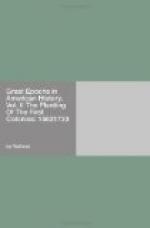In a few instances, witches were believed to have appeared in the earlier years of New England. But the cases had been sporadic. The first instance of an execution for witchcraft is said to have occurred in Connecticut, soon after the settlement [1647, May 30th]; but the circumstances are not known, and the fact has been doubted. A year later, one Margaret Jones, of Charlestown in Massachusetts, and it has been said, two other women in Dorchester and Cambridge, were convicted and executed for the goblin crime. These cases appear to have excited no more attention than would have been given to the commission of any other felony, and no judicial record of them survives....
With three or four exceptions,—for the evidence respecting the asserted sufferers at Dorchester and Cambridge is imperfect,—no person appears to have been punished for witchcraft in Massachusetts, nor convicted of it, for more than sixty years after the settlement, though there had been three or four trials of other persons suspected of the crime. At the time when the question respecting the colonial charter was rapidly approaching an issue, and the public mind was in feverish agitation, the ministers sent out a paper of proposals for collecting facts concerning witchcraft [1681]. This brought out a work from President Mather entitled “Illustrious Providences,” in which that influential person related numerous stories of the performances of persons leagued with the Devil [1684].
The imagination of his restless young son[2] was stimulated, and circumstances fed the flame. In the last year of the government of Andros [1688], a daughter, thirteen years old, of John Goodwin,—a mason living at the South End of Boston,—had a quarrel with an Irish washerwoman about some missing clothes. The woman’s mother took it up, and scolded provokingly. Thereupon the wicked child, profiting, as it seems, by what she had been hearing and reading on the mysterious subject, “cried out upon her,” as the phrase was, as a witch, and proceeded to act the part understood to be fit for a bewitched person; in which behavior she was presently joined by three others of the circle, one of them only four or five years old. Now they would lose their hearing, now their sight, now their speech; and sometimes all three faculties at once. They mewed like kittens; they barked like dogs.
Cotton Mather prayed with one of them; but she lost her hearing, he says, when he began, and recovered it as soon as he finished. Four Boston ministers and one of Charlestown held a meeting, and passed a day in fasting and prayer, by which exorcism the youngest imp was “delivered.” The poor woman, crazed with all this pother,—if in her right mind before,—and defending herself unskilfully in her foreign gibberish and with the volubility of her race, was interpreted as making some confession. A gossiping witness testified that six years before she had heard another woman say that she had seen the accused come down a chimney. She was required to repeat the Lord’s Prayer in English,—an approved test; but being a Catholic, she had never learned it in that language. She could recite it, after a fashion, in Latin; but she was no scholar, and made some mistakes. The helpless wretch was convicted and sent to the gallows.




